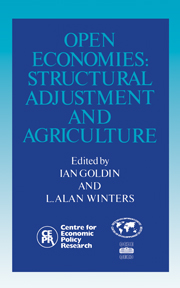Book contents
- Frontmatter
- Contents
- List of figures
- List of tables
- Preface
- Acknowledgements
- List of conference participants
- 1 Introduction: from macro to maize
- Part One Open economy analysis
- Part Two The small country assumption and trade reform
- 6 Exchange reforms, supply response, and inflation in Africa
- Discussion
- 7 Taxes versus quotas: the case of cocoa exports
- Discussion
- 8 Trade reform and the small country assumption
- Discussion
- Part Three Risk and adjustment
- Part Four Government's role
- Index
Discussion
from Part Two - The small country assumption and trade reform
Published online by Cambridge University Press: 04 August 2010
- Frontmatter
- Contents
- List of figures
- List of tables
- Preface
- Acknowledgements
- List of conference participants
- 1 Introduction: from macro to maize
- Part One Open economy analysis
- Part Two The small country assumption and trade reform
- 6 Exchange reforms, supply response, and inflation in Africa
- Discussion
- 7 Taxes versus quotas: the case of cocoa exports
- Discussion
- 8 Trade reform and the small country assumption
- Discussion
- Part Three Risk and adjustment
- Part Four Government's role
- Index
Summary
Introduction
Chapter 6 makes some valuable contributions to the debate on devaluation and exchange reform in sub-Saharan Africa, focusing on their impact on agriculture. Section 2 is devoted to the supply response of agriculture to devaluation, assuming that nominal devaluation leads to real devaluation. Sections 3-5, where most new insights are found, focuses on the inflationary impact of devaluation. The main conclusion is that the devaluation depends on the control regime prevailing in the economy, and on the accompanying policy package.
Devaluation and supply response
Chhibber criticises first the arguments dismissing devaluation on the ground that it prompts poor supply response, as the available evidence shows large response of exports to real devaluation. But a perverse response of imports is possible, perhaps due to the aid boom which often follows an exchange reform. Second, econometric evidence shows that the elasticity of aggregate agricultural response is positive, so that the response of export crops is not obtained at the expense of subsistence crops. Lastly, the evidence cited shows that, when many primary commodities’ exporters devalue simultaneously, boosting their joint exports, the world price of this commodity may fall. But the elasticities are such that export revenues increase in spite of this. Hence, the ‘adding up’ problem does not arise.
Devaluation and inflation
Fears have been raised that the numerous devaluations of the 1980s might pull Africa into a ‘Latin American’ type of inflationary environment. The questions arise whether inflation can offset nominal devaluation so that no real devaluation occurs, and if the size of the nominal devaluation needed to effect a real devaluation, and the ensuing inflation, is affordable.
- Type
- Chapter
- Information
- Open EconomiesStructural Adjustment and Agriculture, pp. 145 - 149Publisher: Cambridge University PressPrint publication year: 1992



